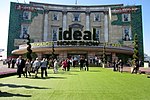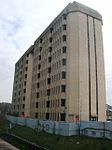St Cuthbert's, Earls Court

St Cuthbert's, Philbeach Gardens (Earls Court), is a Grade I listed Anglican church at 50 Philbeach Gardens, Earls Court, London SW5.The Church was built 1884–87, designed by the architect Hugh Roumieu Gough (1843–1904), son of Alexander Dick Gough. The interior furnishings designed by William Bainbridge Reynolds (1845–1935) who was a member of the congregation. It has been hailed as Jewel of the Arts and Crafts movement of the late 19th and early 20th Centuries. The church is situated on the north west of Philbeach Gardens in Earls Court near the West Cromwell Road (A4). Adjoining the church is the clergy house, and to that the Philbeach Hall. St Cuthberts is noted for its interior decoration and its style of worship.
Excerpt from the Wikipedia article St Cuthbert's, Earls Court (License: CC BY-SA 3.0, Authors, Images).St Cuthbert's, Earls Court
Philbeach Gardens, London Earl's Court (Royal Borough of Kensington and Chelsea)
Geographical coordinates (GPS) Address External links Nearby Places Show on map
Geographical coordinates (GPS)
| Latitude | Longitude |
|---|---|
| N 51.491111111111 ° | E -0.20027777777778 ° |
Address
Saint Cuthbert with Saint Matthias
Philbeach Gardens 50
SW5 9EZ London, Earl's Court (Royal Borough of Kensington and Chelsea)
England, United Kingdom
Open on Google Maps










